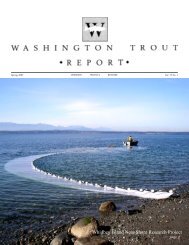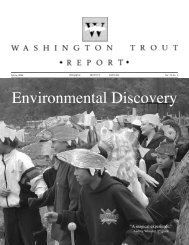Seafood Watch
Pacific Salmon - Wild Fish Conservancy
Pacific Salmon - Wild Fish Conservancy
- No tags were found...
You also want an ePaper? Increase the reach of your titles
YUMPU automatically turns print PDFs into web optimized ePapers that Google loves.
<strong>Seafood</strong> <strong>Watch</strong>® Wild Pacific Salmon Report October 8, 2010<br />
Availability of Science<br />
Pacific salmon are intensively managed for several reasons, including their commercial value,<br />
their anadromous nature, and the listing of depleted salmon ESUs under the Endangered Species<br />
Act. As a result, a large body of both scientific and management literature exists regarding<br />
salmon. Despite the availability of this literature, a number of difficulties in conducting a review<br />
of West Coast salmon fisheries still exist. Assessments of fisheries are complicated by the role of<br />
habitat degradation, climatic oscillations, and other non-fishery related factors in impacting<br />
stocks, as well as by the mixed-stock nature of many salmon fisheries and the shifting role of<br />
hatcheries in salmon conservation and stock augmentation. An abundance of hatchery fish can<br />
mask long-term trends in natural spawners. More importantly, because salmon return to their<br />
natal streams to spawn, there can be and often is a high level of variation between the health of<br />
salmon stocks in relatively close proximity. Given this geographic difference, along with the<br />
remaining uncertainties and complicating factors, this assessment does not claim to review each<br />
individual salmon run. Instead, it provides basic guidelines for assessment, and attempts to make<br />
recommendations on a broad regional basis.<br />
Market Availability<br />
Common and market names:<br />
o Pacific salmon:<br />
o Chinook salmon is also known as king salmon or spring salmon.<br />
o Coho salmon is also known as silver salmon.<br />
o Sockeye salmon is also known as red salmon or blueback salmon.<br />
o Chum salmon is also known as dog salmon.<br />
o Pink salmon is also known as humpback salmon.<br />
o Salmon may also be marketed by the name of their river of origin.<br />
Seasonal availability:<br />
Pacific salmon can typically be found year-round in both retail and service markets, with peak<br />
abundance varying by season and region. The 2010 fisheries for salmon from California and<br />
Oregon (south of Cape Falcon) was small and resulted in mainly a fresh supply of salmon. As<br />
such, salmon from those areas is likely no longer available in the market until the fishing season<br />
opens again in 2011. The wild supply of salmon is augmented by a comparatively small<br />
international production of farmed Pacific salmon. Additionally, large quantities of farmed<br />
Atlantic salmon are available year-round. Farmed salmon are reviewed separately in the <strong>Seafood</strong><br />
<strong>Watch</strong>® Farmed Salmon report.<br />
Product forms:<br />
Pacific salmon are marketed as canned, fresh, or frozen fillets, frozen whole fish, smoked, or<br />
value-added products (e.g., prepared meal portions).<br />
Import and export sources and statistics:<br />
The vast majority of Pacific salmon on the U.S. market is landed domestically, with a large<br />
quantity of landings exported abroad. Since 1980, between 250,000 and 450,000 metric tons (mt)<br />
of Pacific salmon have been landed annually at U.S. ports. By quantity, the main species landed<br />
have been pink and sockeye salmon from Alaska, followed by chum salmon and to a lesser<br />
9






